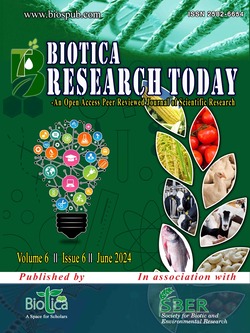
Role of Bacterial Endosymbionts in Biological Control of Insect Pests
Aswathy J.*
Dept. of Entomology, College of Agriculture, Vellayani, Thiruvananthapuram, Kerala (695 522), India
DOI: NIL
Keywords: Endosymbionts, Paratransgenesis, Role, Transmission
Abstract
Endosymbionts are microbial or macrobial organisms that will exhibit a symbiotic relationship with other organisms. Most of the endosymbionts are in the form of intracellular or extracellular in nature. Endosymbionts provide nutrients to the organisms that are essential for the survival and development. Apart from providing nutrients, some endosymbionts play a major role in the management of pests. Examples are Wolbachia, Spiroplasma, Cardinium and Rickettsia. All these endosymbionts are maternally transmitted via transovarial transmission. Their main role is to modify the host reproduction, male killing or host defending. Xenorhabdus and Photorhabdus are the associated endosymbionts of entomopathogenic nematodes are belonging to the genus Steinernema and Heterohabditis. The technique which is suitable to modify the gut microbes genetically for the expression of desired effects in insect is Paratransgenesis. The main aim of utilizing the endosymbionts is to reduce the usage of chemical pesticides in the pest management aspects.
Downloads
not found
Reference
Ashwini, M.N., Bhaskar, H., Mathew, D., Shylaja, M.R., Girija, D., 2022. Isolation and evaluation of bacteria associated with entomopathogenic nematode Heterorhabditis spp. against the spider mite, Tetranychus truncatus Ehara (Acari: Tetranychidae). Egyptian Journal of Biological Pest Control 32, 87. DOI: https://doi.org/10.1186/s41938-022-00586-8.
Krishnamoorthy, R., Jose, P.A., Janahiraman, V., Gandhi, P.I., Gracy, R.G., Jalali, S.K., Kumar, M.S., Malathi, V., Anandham, R., 2020. Function and insecticidal activity of bacteria associated with papaya mealybug, Paracoccus marginatus Williams & Granara de Willink (Hemiptera: Pseudococcidae). Biocontrol Science and Technology 30(8), 762-778. DOI: https://doi.org/10.1080/09583157.2020.1765983.
Sarwar, M.S., Jahan, N., Ali, A., Yousaf, H.K., Munzoor, I., 2022. Establishment of Wolbachia infection in Aedes aegypti from Pakistan via embryonic microinjection and semi-field evaluation of general fitness of resultant mosquito population. Parasites and Vectors 15, 191. DOI: https://doi.org/10.1186/s13071-022-05317-4.
Schmitz, A., Anselme, C., Ravallec, M., Rebuf, C., Simon, J.C., Gatti, J.L., Poirie, M., 2012. The cellular immune response of the pea aphid to foreign intrusion and symbiotic challenge. PLoS ONE 7(7), e42114. DOI: https://doi.org/10.1371/journal.pone.0042114.
Yuksel, E., 2022. Biocontrol potential of endosymbiotic bacteria of entomopathogenic nematodes against the tomato leaf miner, Tuta absoluta (Meyrick) (Lepidoptera: Gelechiidae). Egyptian Journal of Biological Pest Control 32, 135. DOI: https://doi.org/10.1186/s41938-022-00633-4.
